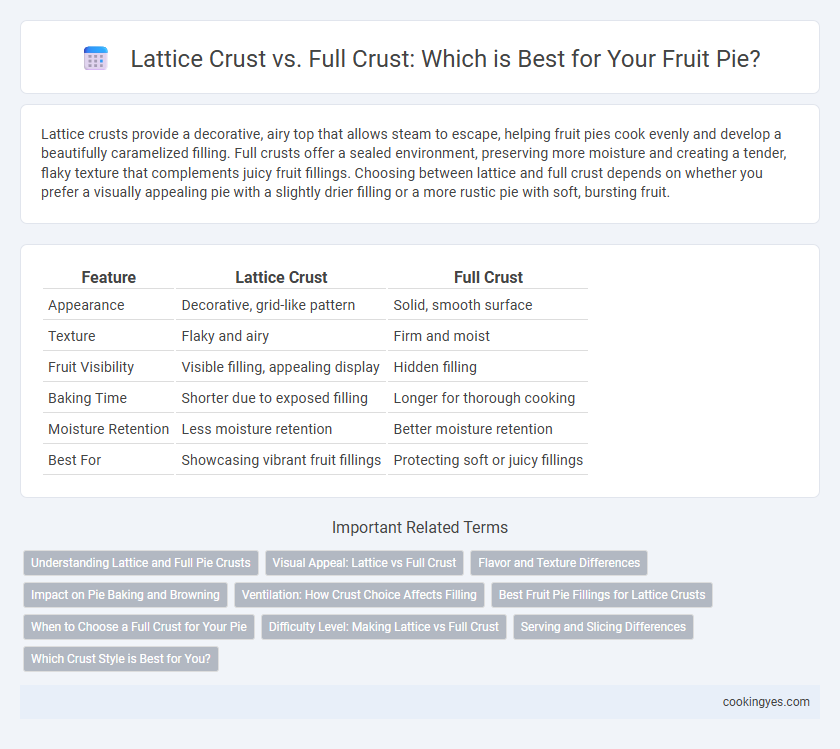Lattice crusts provide a decorative, airy top that allows steam to escape, helping fruit pies cook evenly and develop a beautifully caramelized filling. Full crusts offer a sealed environment, preserving more moisture and creating a tender, flaky texture that complements juicy fruit fillings. Choosing between lattice and full crust depends on whether you prefer a visually appealing pie with a slightly drier filling or a more rustic pie with soft, bursting fruit.
Table of Comparison
| Feature | Lattice Crust | Full Crust |
|---|---|---|
| Appearance | Decorative, grid-like pattern | Solid, smooth surface |
| Texture | Flaky and airy | Firm and moist |
| Fruit Visibility | Visible filling, appealing display | Hidden filling |
| Baking Time | Shorter due to exposed filling | Longer for thorough cooking |
| Moisture Retention | Less moisture retention | Better moisture retention |
| Best For | Showcasing vibrant fruit fillings | Protecting soft or juicy fillings |
Understanding Lattice and Full Pie Crusts
Lattice crusts provide a visually appealing design with woven strips of dough that allow steam to escape, enhancing the fruit's natural sweetness and reducing sogginess. Full crusts offer a sealed, protective layer that locks in moisture, resulting in a tender, juicy filling with a golden-brown, flaky top. Both crust styles impact texture and baking dynamics, making the choice dependent on desired presentation and flavor concentration.
Visual Appeal: Lattice vs Full Crust
A lattice crust showcases the vibrant fruit filling through its woven design, enhancing visual appeal with a rustic, artisanal look that invites anticipation. In contrast, a full crust offers a smooth, uniform surface that can be intricately decorated with patterns or cutouts, providing a classic and polished presentation. Both crust styles contribute differently to fruit pies, with lattice emphasizing texture and color contrast, while full crust highlights craftsmanship and a clean, elegant appearance.
Flavor and Texture Differences
Lattice crusts allow more steam to escape during baking, resulting in a drier, crispier texture that enhances the natural sweetness and tartness of fruit fillings. Full crusts trap moisture, creating a softer, more tender texture with a richer, buttery flavor from the enclosed dough. The lattice design intensifies fruit aromas through exposed filling, while the full crust provides a balanced blend of fruit and pastry flavors encased in a golden, flaky shell.
Impact on Pie Baking and Browning
Lattice crust pies allow steam to escape more efficiently during baking, resulting in a crispier and more evenly browned crust compared to full crust pies. The open design of the lattice crust promotes better airflow, which enhances caramelization of the fruit filling and prevents sogginess. Full crust pies retain more moisture, often leading to a softer crust and less pronounced browning on the top surface.
Ventilation: How Crust Choice Affects Filling
Lattice crusts provide superior ventilation for fruit pies, allowing steam to escape and preventing the filling from becoming overly watery or mushy. Full crusts trap moisture beneath the top layer, which can result in a denser filling with less pronounced fruit texture. Proper steam release through a lattice crust enhances the pie's overall flavor concentration and preserves the natural consistency of the fruit filling.
Best Fruit Pie Fillings for Lattice Crusts
Lattice crusts enhance fruit pies by allowing steam to escape and juices to thicken, making them ideal for fillings like cherry, blueberry, and mixed berry blends. The open design of lattice crusts highlights the vibrant colors and textures of fruits such as raspberries, blackberries, and peaches while providing a balance of crispiness and moisture. For optimal results, choose fillings with medium to thick consistency and acidity that hold their shape under the lattice, ensuring a visually appealing and flavorful pie.
When to Choose a Full Crust for Your Pie
Choose a full crust for your fruit pie when you want to trap moisture and create a juicier filling, especially with softer fruits like berries or peaches. Full crusts also provide a more traditional appearance and protect the filling during longer baking times, preventing it from spilling over. Opt for a full crust to achieve a sturdier texture and a classic pie experience.
Difficulty Level: Making Lattice vs Full Crust
Lattice crusts require a higher skill level due to the intricate weaving of dough strips, demanding precision and patience to achieve an even, visually appealing pattern. Full crusts are simpler to prepare, involving rolling out a single sheet of dough to cover the fruit filling, making it more suitable for beginner bakers. Mastery of lattice crust techniques improves pie aesthetics and ventilation, while full crusts provide a straightforward, protective barrier that locks in moisture.
Serving and Slicing Differences
Lattice crust pies offer a visually appealing presentation with visible fruit filling, making it easier to identify slices without mixing flavors, while full crust pies provide a uniform, sealed top that maintains moisture and integrity during serving. Slicing a lattice crust pie often requires careful handling to preserve the delicate strips, whereas full crust pies allow cleaner, more structured cuts without as much risk of breaking apart. Both crust types impact how the pie holds together on the plate, influencing the balance between aesthetic and ease of serving.
Which Crust Style is Best for You?
Choosing between a lattice crust and a full crust for fruit pies depends on your preference for texture, appearance, and baking time. A lattice crust offers a decorative, airy top that allows steam to escape, preventing sogginess and highlighting the fruit filling's vibrant colors. In contrast, a full crust provides a classic, sealed top that locks in moisture and creates a tender, flaky layer, ideal for those who enjoy a heartier pastry experience.
Lattice crust vs full crust for fruit pie Infographic

 cookingyes.com
cookingyes.com